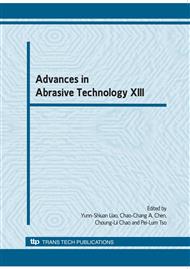p.381
p.388
p.394
p.401
p.407
p.415
p.423
p.429
p.435
An Investigation of Attachment on Electrode Surface in Dry EDM
Abstract:
Dry Electrical discharge machining (Dry EDM), using gas as dielectric, has been developed to solve problems against environment. It has both advantages of high material removal ratio (MRR) and low relative electrode wear ratio (REWR). We investigated the effect of duty factor, peak current, and reference ratio of gap voltage on MRR and REWR of Dry EDM, respectively. Moreover, trying to prove the attachment on electrode surface could decline REWR. It is considered that melting material of work-piece was sputtered and stuck onto electrode surface, and to become a protection layer as result in low REWR. However, the attachment will be removed under the condition of high peak current and high discharge frequency. But the amount of attachment just has little change when discharge number and arc discharge ratio are both decrease.
Info:
Periodical:
Pages:
407-412
Citation:
Online since:
August 2010
Authors:
Price:
Сopyright:
© 2010 Trans Tech Publications Ltd. All Rights Reserved
Share:
Citation:


